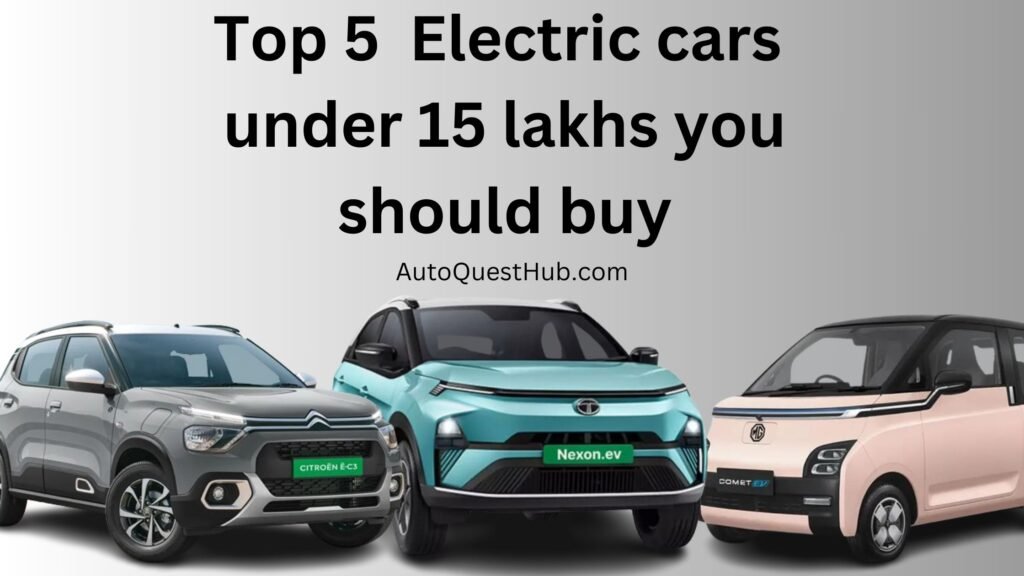
Top 5 Electric Cars Under 15 Lakhs in India
Plug In and Drive Green
Introduction
The Indian automotive landscape is shifting gears towards a greener future. Electric vehicles (EVs) are no longer a futuristic fantasy, but a viable and exciting option for eco-conscious drivers. With the government pushing for EV adoption and manufacturers offering compelling choices, finding the perfect electric car under 15 lakhs is easier than ever.
This guide dives into the top 5 electric cars under 15 lakhs in India, highlighting their key features, driving range, and unique selling points. Whether you’re a budget-minded commuter or an SUV enthusiast, this curated list offers something for everyone. So, buckle up and get ready to discover the future of electric mobility in India.
1. MG Coment Ev Zippy City with Budget Appeal
The MG Comet EV zooms into the electric car market as a stylish and affordable option for urban commutes. This compact hatchback packs a punch in terms of design and functionality, making it a compelling choice for city dwellers.
Sleek & Practical: The Comet EV boasts a modern design with clean lines and a spacious interior for its size. Despite its compact footprint, it comfortably seats four passengers.
Electric Performance: Powered by a permanent magnet synchronous motor and a 17.3 kWh lithium-ion battery, the Comet EV delivers a zippy performance with a claimed maximum power output of 41.42 bhp and a peak torque of 110 Nm. While acceleration won’t leave you breathless, it offers a smooth and comfortable ride for daily commutes.
Charging Up: The MG Comet EV supports AC charging with a standard 3.3 kW charger, taking approximately 7 hours for a full charge from 0 to 100%. While DC fast charging isn’t currently available, the AC charging time is suitable for overnight charging at home.
Range on a Single Charge: The MG Comet EV boasts a claimed driving range of up to 230 km on a single charge, making it ideal for navigating city streets and running errands. This range is sufficient for most daily commutes without the need for frequent recharging.
Safety Features: MG prioritizes safety with the inclusion of dual front airbags, ABS with EBD (Electronic Brake-force Distribution), a tire pressure monitoring system, and a reverse parking camera.
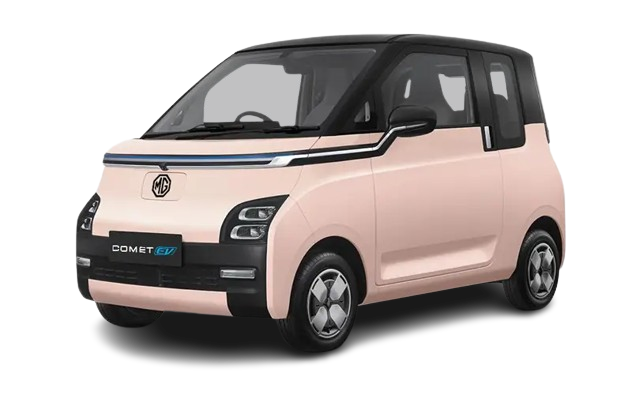
Specification
| Feature | Specification |
|---|---|
| Battery Capacity | 17.3 kWh Lithium-Ion |
| Motor Power | 41.42 bhp (30.9 kW) |
| Peak Torque | 110 Nm |
| Claimed Driving Range | 230 km |
| Charging Time (AC 3.3 kW) | 0-100% in 7 hours |
| Seating Capacity | 4 |
| Safety Features | Dual Front Airbags, ABS with EBD, TPMS, Reverse Parking Camera |
Ex-Showroom Price: The MG Comet EV offers a budget-friendly entry point into the electric car segment. Prices start at a competitive ₹6.99 lakh (ex-showroom) and can vary depending on the chosen variant.
Overall, the MG Comet EV is a compelling choice for urban drivers seeking a stylish, practical, and affordable electric car for everyday commutes. It offers a comfortable driving experience, a decent range, and essential safety features, all at an attractive price point.
2. Tata Nexon EV: The Capable Contender in the Electric SUV Arena
The Tata Nexon EV carves a niche in the electric vehicle market, offering a compelling combination of SUV practicality, impressive range, and competitive pricing. Let’s delve into the details of this popular electric SUV.
SUV Stature with Electric Appeal: The Nexon EV retains the rugged good looks and spacious cabin of its petrol counterpart, making it a practical choice for families or those who need extra cargo space.
Electric Performance: Two battery pack options are available: a 30.2 kWh battery for a claimed range of 315 km and a larger 40.5 kWh battery for a claimed range of up to 437 km (ARAI certified). Both variants are powered by a permanent magnet synchronous motor delivering a maximum power output of 100 kW (136 bhp) and peak torque of 245 Nm. This combination ensures a smooth and responsive driving experience.
Charging Up: The Nexon EV supports both AC and DC fast charging. A 3.3 kW AC charger can fully charge the battery in approximately 10 hours (30.2 kWh) or 14 hours (40.5 kWh). DC fast charging allows for a 0-80% charge in approximately 60 minutes (fast charging availability depends on the charging station infrastructure).
Safety First: Tata prioritizes occupant safety with the Nexon EV. It boasts a 5-star Global NCAP safety rating, thanks to features like dual airbags, ABS with EBD, corner stability control, and a traction control system.
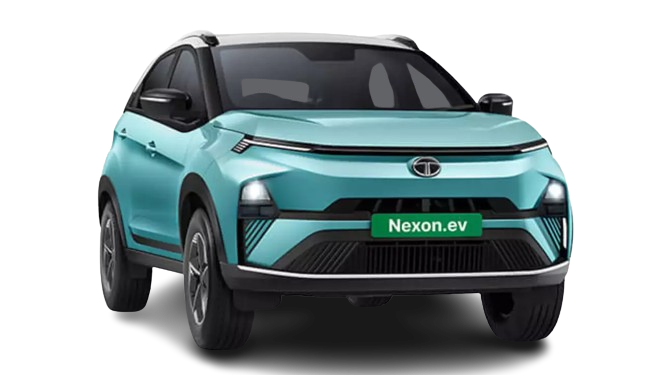
Specification
| Feature | Specification (30.2 kWh Battery) | Specification (40.5 kWh Battery) |
|---|---|---|
| Battery Capacity | 30.2 kWh Lithium-Ion | 40.5 kWh Lithium-Ion |
| Motor Power | 100 kW (136 bhp) | 100 kW (136 bhp) |
| Peak Torque | 245 Nm | 245 Nm |
| Claimed Driving Range (ARAI) | 315 km | 437 km |
| AC Charging Time (3.3 kW) | 0-100% in 10 hours (approx.) | 0-100% in 14 hours (approx.) |
| DC Fast Charging Time (0-80%) | 60 minutes (approx.) | 60 minutes (approx.) |
| Seating Capacity | 5 | |
| Safety Features | Dual Airbags, ABS with EBD, Corner Stability Control, Traction Control System |
Ex-Showroom Price: The Nexon EV caters to a wider budget range with prices starting from ₹14.54 lakh (ex-showroom) for the base variant with the 30.2 kWh battery. The price increases with higher trims and the larger 40.5 kWh battery pack.
Overall, the Tata Nexon EV emerges as a strong contender in the electric SUV segment. It offers a blend of practicality, impressive range (especially with the larger battery), and competitive pricing. The inclusion of a 5-star safety rating further enhances its appeal. If you’re seeking a capable and feature-rich electric SUV for everyday commutes and occasional adventures, the Nexon EV is definitely worth considering.
3.Citroen eC3: A Stylish and Spacious Electric Hatchback for Urban Adventures.
The Citroen eC3 (pronounced “e-C3”) brings a touch of European flair to the electric car market in India. This stylish electric hatchback combines modern design with practicality, making it a compelling choice for urban commutes and occasional weekend getaways.
Citroen’s Electric Debut: The eC3 marks Citroen’s entry into the electric vehicle segment in India. It retains the quirky and modern design language of the Citroen brand, featuring a split headlamp design, bold grille, and stylish two-tone color options.
Spacious and Practical: Despite its compact size, the eC3 offers a surprisingly spacious interior with ample legroom and headroom for five passengers. The cargo area provides enough space for luggage and groceries for everyday needs.
Electric Performance: The eC3 is powered by a permanent magnet synchronous motor paired with a 29.1 kWh lithium-ion battery. This combination delivers a maximum power output of 57 kW (78 bhp) and a peak torque of 245 Nm. While acceleration won’t leave you breathless, it offers a smooth and comfortable ride for city commutes.
Charging Up: The eC3 supports AC charging with a standard 3.3 kW charger, taking approximately 10 hours and 30 minutes for a full charge from 0 to 100%. DC fast charging is not currently available for the eC3.
Claimed Driving Range: The eC3 boasts a claimed driving range of up to 320 km on a single charge (ARAI certified). This range is sufficient for most daily commutes and even short weekend trips without needing frequent recharging.
Safety First: Citroen prioritizes safety with the eC3. It comes equipped with dual front airbags, ABS with EBD, corner stability control, a hill-start assist system, and a reverse parking camera. Higher trims may offer additional safety features.
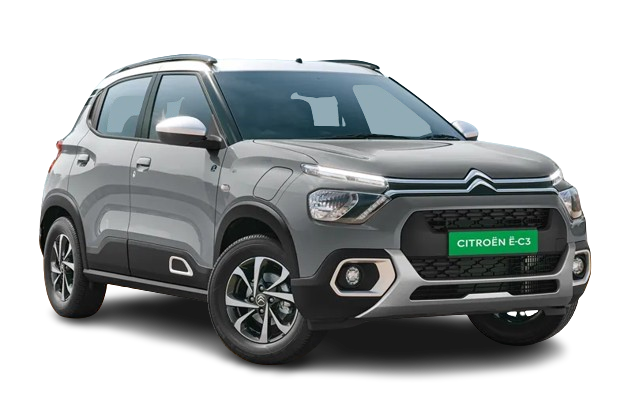
Specification
| Feature | Specification |
|---|---|
| Battery Capacity | 29.1 kWh Lithium-Ion |
| Motor Power | 57 kW (78 bhp) |
| Peak Torque | 245 Nm |
| Claimed Driving Range (ARAI) | 320 km |
| AC Charging Time (3.3 kW) | 0-100% in 10 hours 30 min (approx.) |
| DC Fast Charging | Not Available |
| Seating Capacity | 5 |
| Safety Features | Dual Front Airbags, ABS with EBD, Corner Stability Control, Hill Start Assist, Reverse Parking Camera |
Ex-Showroom Price: The Citroen eC3 falls within the mid-range of the electric hatchback segment. Prices start from ₹11.61 lakh (ex-showroom) and can vary depending on the chosen variant.
Overall, the Citroen eC3 is a stylish and practical electric hatchback that offers a comfortable driving experience, a decent driving range, and a focus on safety. It’s a compelling choice for urban drivers seeking a unique and modern electric car for everyday journeys.
4. Tata Punch EV: The Spirited Subcompact SUV with Electric.
The Tata Punch EV electrifies the subcompact SUV segment, offering a blend of practicality, punchy performance, and a budget-conscious approach. Let’s delve into the details of this feisty electric SUV.
SUV Stature, Electric Heart: The Punch EV retains the rugged good looks and high seating position of its petrol counterpart, making it a practical choice for navigating city streets and occasional off-road adventures. The electric powertrain adds a touch of eco-friendliness without compromising on the SUV spirit.
Electric Performance: Two battery pack options are available: a 25 kWh battery for a claimed range of 315 km and a larger 35 kWh battery for a claimed range of up to 421 km (ARAI certified). Both variants are powered by a permanent magnet synchronous motor delivering a maximum power output of 61 kW (83 bhp) and peak torque of 114 Nm. This combination ensures a peppy and responsive driving experience for both city commutes and highway cruising.
Charging Up: The Punch EV supports AC charging with a standard 3.3 kW charger, taking approximately 9 hours and 6 minutes (25 kWh) or 12 hours and 46 minutes (35 kWh) for a full charge from 0 to 100%. DC fast charging is not currently available for the Punch EV.
Safety First: Tata prioritizes safety with the Punch EV. It boasts a 5-star Global NCAP safety rating, thanks to features like dual airbags, ABS with EBD, corner stability control, traction control system, and a hill hold assist system.

specification
| Feature | Specification (25 kWh Battery) | Specification (35 kWh Battery) |
|---|---|---|
| Battery Capacity | 25 kWh Lithium-Ion | 35 kWh Lithium-Ion |
| Motor Power | 61 kW (83 bhp) | 61 kW (83 bhp) |
| Peak Torque | 114 Nm | 114 Nm |
| Claimed Driving Range (ARAI) | 315 km | 421 km |
| AC Charging Time (3.3 kW) | 0-100% in 9 hours 6 min (approx.) | 0-100% in 12 hours 46 min (approx.) |
| DC Fast Charging | Not Available | Not Available |
| Seating Capacity | 5 | |
| Safety Features | Dual Airbags, ABS with EBD, Corner Stability Control, Traction Control System, Hill Hold Assist |
Ex-Showroom Price: The Punch EV caters to a wider budget range with prices starting from ₹10.99 lakh (ex-showroom) for the base variant with the 25 kWh battery. The price increases with higher trims and the larger 35 kWh battery pack.
Overall, the Tata Punch EV emerges as a compelling option in the electric subcompact SUV segment. It offers a blend of SUV practicality, punchy performance with two range options, and a focus on safety with a 5-star NCAP rating. If you’re seeking a fun and practical electric SUV for city commutes and weekend getaways, the Punch EV is definitely worth considering.
* Tata Tiago EV: The Budget-Friendly Electric Hatchback for Everyday Journeys
Tata Tigor EV: The Spacious Electric Sedan for Family and Friends
The Tata Tiago EV electrifies the hatchback segment, offering a practical and affordable option for eco-conscious drivers. This feature-packed electric car caters to city commutes and everyday errands, making it a compelling choice for budget-minded buyers.
Hatchback Convenience with Electric Efficiency: The Tiago EV retains the familiar hatchback design of its petrol sibling but with a focus on electric efficiency. The spacious cabin comfortably seats five passengers, making it suitable for small families or friends.
Electric Performance: Two battery pack options are available: a 19.2 kWh battery for a claimed range of 250 km and a larger 24 kWh battery for a claimed range of up to 315 km (ARAI certified). Both variants are powered by a permanent magnet synchronous motor delivering a maximum power output of 74 kW (99 bhp) and peak torque of 114 Nm. This combination ensures a smooth and peppy driving experience for city commutes.
Charging Up: The Tiago EV supports AC charging. A standard 3.3 kW charger can fully charge the battery in approximately 7 hours and 10 minutes (19.2 kWh) or 11 hours and 45 minutes (24 kWh). DC fast charging is not currently available for the Tiago EV.
Safety Features: Tata prioritizes safety with the Tiago EV. It comes equipped with dual front airbags, ABS with EBD, corner stability control, and a reverse parking sensor. Higher trims offer additional safety features like a passenger airbag and automatic headlamps.
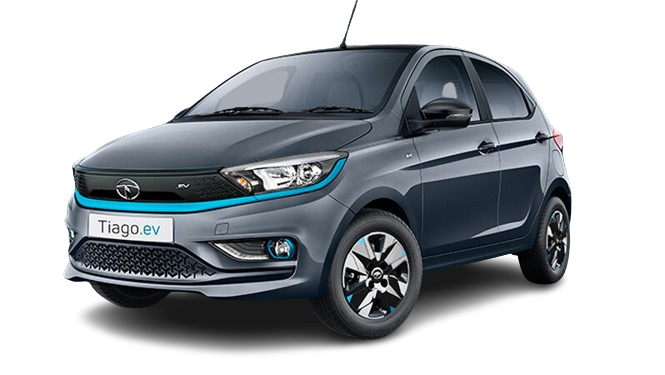

please Note :- Tata tiago and tigor both are same the difference tiago is a hatchback and tigor is sedan cars and they both have different prices.
specification
| Feature | Specification (19.2 kWh Battery) | Specification (24 kWh Battery) |
|---|---|---|
| Battery Capacity | 19.2 kWh Lithium-Ion | 24 kWh Lithium-Ion |
| Motor Power | 74 kW (99 bhp) | 74 kW (99 bhp) |
| Peak Torque | 114 Nm | 114 Nm |
| Claimed Driving Range (ARAI) | 250 km | 315 km |
| AC Charging Time (3.3 kW) | 0-100% in 7 hours 10 min (approx.) | 0-100% in 11 hours 45 min (approx.) |
| DC Fast Charging | Not Available | Not Available |
| Seating Capacity | 5 | 5 |
| Safety Features | Dual Front Airbags, ABS with EBD, Corner Stability Control, Reverse Parking Sensor | (May vary depending on trim) Dual Front Airbags, Passenger Airbag, ABS with EBD, Corner Stability Control, Reverse Parking Sensor, Automatic Headlamps |
Ex-Showroom Price: The Tata Tiago EV makes a strong case for affordability in the electric car segment. Prices start from a competitive ₹7.99 lakh (ex-showroom) for the base variant with the 19.2 kWh battery. The price increases with higher trims and the larger 24 kWh battery pack.
Ex-Showroom Price Tigor : The Tigor EV falls within the mid-range of the electric sedan segment. Prices start from ₹12.49 lakh (ex-showroom) and can vary depending on the chosen variant.
Overall, the Tata Tiago EV is a practical and budget-friendly option for eco-conscious drivers seeking a reliable electric car for everyday commutes. It offers a good balance of range, performance, and features, making it a compelling choice in the electric hatchback market.
Overall, the Tata Tigor EV is a practical and spacious electric sedan that offers a comfortable driving experience, a decent driving range, and a focus on safety. It’s a compelling choice for families or those seeking a comfortable electric car for everyday commutes and occasional longer journeys.
thanks coming on my post. Kindly write yours suggest and share some more knowledge with with me in the comment box and visit our blog section.
General FAQs:
What are the benefits of electric cars?
- EVs produce zero tailpipe emissions, reducing air pollution.
- They are generally quieter than gasoline-powered cars.
- Electricity can be a cheaper fuel source than gasoline, especially with home charging.
- Government incentives can make EVs more affordable to purchase.
What are the challenges of electric cars?
- Limited driving range compared to gasoline cars (although this is improving rapidly).
- Fewer charging stations compared to gas stations, especially for DC fast charging.
- Longer charging times compared to refueling with gasoline.
- Higher upfront cost of the vehicle compared to gasoline cars (although the total cost of ownership can be lower over time).
How much does it cost to charge an electric car?
- The cost of charging an electric car will vary depending on electricity rates in your area and the efficiency of the car. However, it is generally much cheaper to charge an electric car than to fill up a gasoline car.
How long does it take to charge an electric car?
- Charging times can vary depending on the size of the battery pack, the type of charger used (AC level 1, AC level 2, or DC fast charging), and the available power outlet. A typical Level 2 charger can fully charge a moderate-sized battery pack in 6-8 hours, while a DC fast charger can add up to 80% charge in 30 minutes or less.
Buying an EV:
What factors should I consider when buying an electric car?
- Your typical driving range and needs.
- Availability of charging stations at home, work, and along your regular routes.
- Features and cargo space requirements.
- Government incentives available in your region.
- Total cost of ownership, including charging costs and maintenance.
Where can I find information about government incentives for electric cars?
- You can find information about government incentives for electric cars in your region by searching online or contacting your local government agency.
How much does it cost to maintain an electric car?
- Electric cars generally require less maintenance than gasoline cars because they have fewer moving parts. The main maintenance costs will be for tire rotations, wiper blades, and routine inspections.
Owning an EV:
How can I find charging stations for my electric car?
- There are a number of apps and websites that can help you find charging stations for your electric car. Popular options include PlugShare, ChargePoint, and the apps from major electric car manufacturers.
What is the difference between AC and DC charging?
- AC (Alternating Current) charging is slower but more widely available. Level 1 AC charging is typically used for overnight charging at home using a standard outlet. Level 2 AC charging is faster and is available at public charging stations and some workplaces.
- DC (Direct Current) fast charging is the fastest way to charge an electric car, but DC fast chargers are less common than AC chargers.
Can I charge my electric car at home?
- Yes, you can charge your electric car at home using a Level 1 or Level 2 charger. Installing a Level 2 charger at home is the most convenient and fastest way to charge your car.
